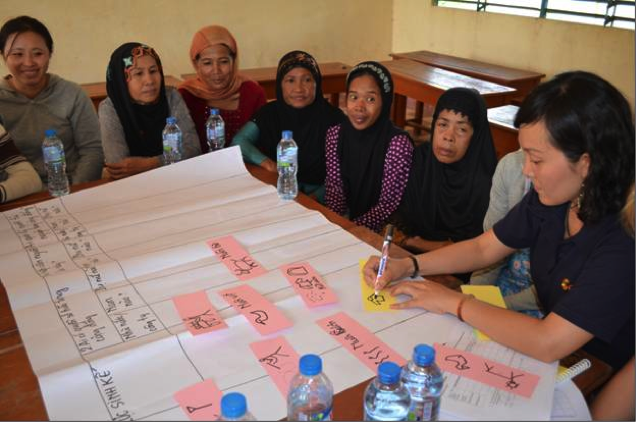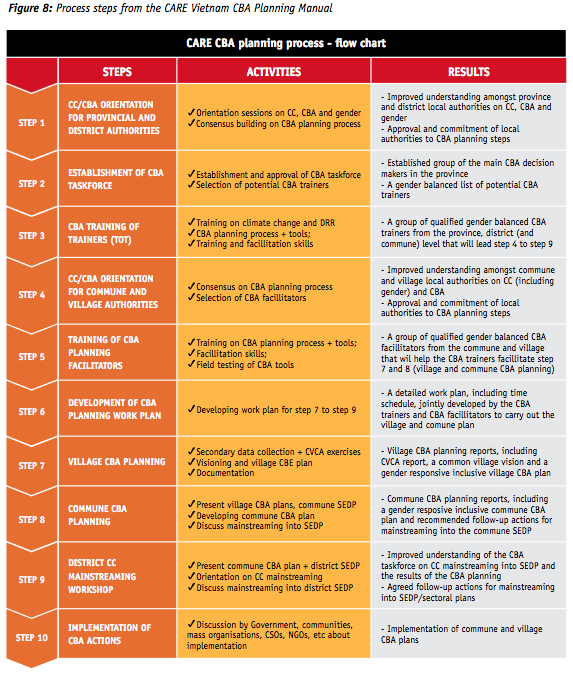A methodology for CBA planning in Vietnam


Women from four villages in Khanh Binh commune, An Phu District, discuss existing livelihood activities as part of the resilient livelihood study.
A methodology for CBA planning in Vietnam
The overall aim of the Integrated Community-based Adaptation in the Mekong Delta (ICAM) project is to increase the resilience of communities in the Mekong Delta to the unavoidable impacts of climate change. The project targets the most vulnerable people – specifically landless and land-poor people, with a particular focus on minority ethnic groups such as the Cham and Khmer, living in five communes in the provinces of Soc Trang and An Giang. In close collaboration with partners,[1] the project is building local capacity to carry out improved gender-sensitive analysis and planning for CBA. In addition, it is providing support for the implementation of disaster risk reduction (DRR) measures and climate-resilient livelihoods, and strengthening civil society in the Mekong Delta.
In order to produce community-based adaptation plans, the project wanted to use CARE’s various good practices and proven tools such as the Climate Vulnerability and Capacity Assessment (CVCA) manual; the community Visioning tool and programme experience on integrating CBA with disaster risk reduction in development planning. Combining these approaches, however, proved to be quite a challenge, for partners as well as project staff. It was jointly agreed to put the project activities on hold for a few weeks and develop a simple, and easy to replicate, step-by-step CBA planning methodology.
First the project team identified components that overlapped between the different tools. Then each one was combined in a step-by-step process aligned with government planning processes – in particular socio-economic development and community-based disaster risk management planning. As the CBA planning approach has to be adopted and replicated by local government representatives in different settings, the methodology takes into account the time and human resources available within government and project partners.
Agreement on the key practical steps to be followed in the early phase of the methodology development was absolutely vital. After an agreement was reached, the CBA planning process was detailed step by step, through the drafting of a CBA planning manual. All related tools and other materials required to carry out the process were also added. The manual has now been tested in the project, revised, finalised and shared with NGOs, civil society organisations, donors and government bodies in the wider climate change adaptation community. It is hoped that this resource will greatly contribute to improved sharing and knowledge management on CBA in Vietnam and the region as a whole.

Process steps from the CARE Vietnam CBA Planning Manual
Disaster risk reduction strategies to reduce the impact of hazards on vulnerable households
The project has now completed gender-sensitive and inclusive CBA planning in all project villages and communes, with government approval of recommended community-led adaptation activities integrated into commune and district DRR and development plans. A pool of government representatives from provincial, district, and commune-level offices have been trained in CBA planning, in alignment with government climate change and DRR planning processes. Swimming skills training, a flood warning system, child safety information and tree planting for the prevention of soil erosion are just some of the activities being jointly funded by the project and government.
Promotion of climate-resilient livelihoods strategies
The project has also completed a comprehensive action research study on climate-resilient livelihoods. This has resulted in a draft methodology (not yet published) for identifying livelihood strategies that are climate resilient, and a range of support options for target beneficiaries in An Giang and Soc Trang provinces. The project, through local partners, provides support for organic eel raising, organic indoor mushroom farming, onion-waste based bio-fertiliser production, drip irrigation techniques, bio-bedding for pig manure management, floating food gardens and chilli growing.
In addition, to help diversify income and enhance income security, microfinance for climate change adaptation activities is now available through customisation of the existing Women’s Union credit system, which can now extend its reach to more women, including minority ethnic women and disabled women. These women, who previously had to rely on risky informal loans, now have access to a reliable source of finance.
Advocacy and social mobilisation to address the underlying causes of vulnerability
Project activities are also raising the voices of vulnerable Cham women and men, living on boats or in unprotected houses on the river, through innovative community digital photo story telling. This is a community-driven project that allows people to tell their own stories about inequality, climate change and social marginalisation through videos made using photographs and narration.
Capacity development for local civil society and government institutions
The project has enhanced civil society networking, information-sharing, learning and collaboration on climate change through the joint establishment and operation of the Southern Climate Change Working Group. This group brings together Vietnamese civil society, international NGOs, research institutes and bilateral funding organisations.
(0) Comments
There is no content